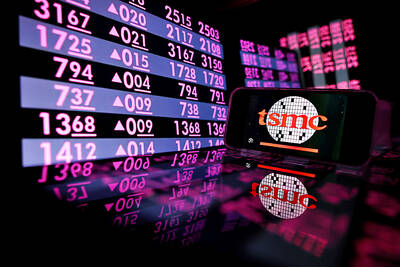Honda Motor Co absorbing Nissan Motor Co could give the two struggling Japanese brands the scale they need to take on China’s BYD Co (比亞迪), sales figures released yesterday showed.
Honda, which earlier this week sketched out plans for a deal that amounts to an acquisition of Nissan, sold 3.43 million cars globally in the first 11 months of this year. Nissan said it sold just over 3 million.
China’s biggest automaker BYD sold 3.76 million vehicles over the same period — a clear illustration of how Nissan and Honda are weak alone, but together might have a fighting chance.

Photo: Kyodo via Reuters
Honda and Nissan are having trouble contending with ascendant domestic automakers in China, which surpassed Japan as the world’s largest car exporter last year and is set to pull further ahead next year.
The duo have had to pare back staffing and production in China, while Mitsubishi Motors Corp, which might also participate in the Honda-Nissan combination, has all but pulled out of the world’s biggest car market.
Honda’s sales in China fell 28 percent last month compared with the same month of last year, while output slumped 38 percent year-on-year.
Any spending Honda might need to do to catch up could be impacted by its ¥1.1 trillion (US$7 billion) buyback, S&P Global Inc said in a report.
“Large-scale share repurchases do not contribute to strengthening the future business base and result in capital outflows,” the ratings agency added.
Honda announced the buyback on Monday. The upper limit amounts to 24 percent of issued shares. Stock in Honda closed up 0.8 percent yesterday.
Nissan’s China sales dropped 15.1 percent last month, while local production sank 26 percent.
Globally, Honda’s sales last month slipped 6.7 percent to 324,504 units, while output tumbled 20.4 percent. Nissan’s worldwide sales declined 1.3 percent year-on-year last month to 278,763 vehicles, while production took a bigger hit at 14.3 percent.
Together, Honda and Nissan would also pose more of a threat to Toyota Motor Corp, which is the world’s biggest automaker followed by Germany’s Volkswagen AG. Its global sales plateaued last month as lackluster demand coalesced with a pause in production at two of its plants.
Toyota’s sales — including that of subsidiaries Daihatsu Motor Co and Hino Motors Ltd — totaled 984,348 units last month, the Japanese automaker said yesterday, down 0.2 percent year-on-year. Production declined 9.4 percent to 966,921 units.
Toyota’s business is also feeling the strain of locally made electric vehicles in China as well as intense competition over hybrid gasoline-electric cars in the US.
Like Honda and Nissan, its hold on markets across Southeast Asia is being steadily eroded by Chinese competitors, too.
More broadly, weaker global demand this year for new cars was compounded by output cuts at Toyota caused by regulatory probes, and recalls in Japan and abroad.
Production in the first 11 months fell 7.3 percent in Japan and 15.2 percent in China for Toyota, again underscoring the rising competition in Asia’s biggest economy.
Toyota’s production in China, or vehicles off the delivery line as opposed to end-consumer sales, declined 1.6 percent last month.
Shares in Toyota gained as much as 4.4 percent yesterday.

Taiwan Semiconductor Manufacturing Co (TSMC, 台積電) yesterday said that its investment plan in Arizona is going according to schedule, following a local media report claiming that the company is planning to break ground on its third wafer fab in the US in June. In a statement, TSMC said it does not comment on market speculation, but that its investments in Arizona are proceeding well. TSMC is investing more than US$65 billion in Arizona to build three advanced wafer fabs. The first one has started production using the 4-nanometer (nm) process, while the second one would start mass production using the

When an apartment comes up for rent in Germany’s big cities, hundreds of prospective tenants often queue down the street to view it, but the acute shortage of affordable housing is getting scant attention ahead of today’s snap general election. “Housing is one of the main problems for people, but nobody talks about it, nobody takes it seriously,” said Andreas Ibel, president of Build Europe, an association representing housing developers. Migration and the sluggish economy top the list of voters’ concerns, but analysts say housing policy fails to break through as returns on investment take time to register, making the

‘SILVER LINING’: Although the news caused TSMC to fall on the local market, an analyst said that as tariffs are not set to go into effect until April, there is still time for negotiations US President Donald Trump on Tuesday said that he would likely impose tariffs on semiconductor, automobile and pharmaceutical imports of about 25 percent, with an announcement coming as soon as April 2 in a move that would represent a dramatic widening of the US leader’s trade war. “I probably will tell you that on April 2, but it’ll be in the neighborhood of 25 percent,” Trump told reporters at his Mar-a-Lago club when asked about his plan for auto tariffs. Asked about similar levies on pharmaceutical drugs and semiconductors, the president said that “it’ll be 25 percent and higher, and it’ll

CHIP BOOM: Revenue for the semiconductor industry is set to reach US$1 trillion by 2032, opening up opportunities for the chip pacakging and testing company, it said ASE Technology Holding Co (日月光投控), the world’s largest provider of outsourced semiconductor assembly and test (OSAT) services, yesterday launched a new advanced manufacturing facility in Penang, Malaysia, aiming to meet growing demand for emerging technologies such as generative artificial intelligence (AI) applications. The US$300 million facility is a critical step in expanding ASE’s global footprint, offering an alternative for customers from the US, Europe, Japan, South Korea and China to assemble and test chips outside of Taiwan amid efforts to diversify supply chains. The plant, the company’s fifth in Malaysia, is part of a strategic expansion plan that would more than triple